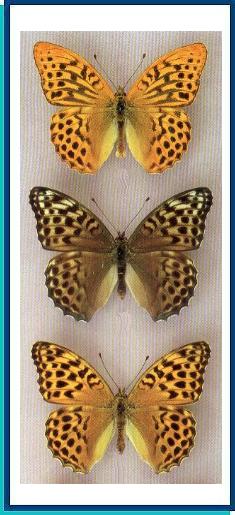LEPIDOPTERA
N Y M P H A L I D A E Swainson, 1827
ARGYNNIS Fabricius, 1807
Argynnis paphia (Linnaeus, 1758)
Argynnis paphia (Linnaeus, 1758)

• TYPE LOCALITY. [Sweden].
• SYNONYM. anargyra Staudinger, 1871.
• RANGE. From W. Europe across the European part of Russia, the Caucasus and Transcaucasia, the N. Tian-Shan, the Dzhungarsky Alatau, W. and central Siberia, the Far East, the Amur and Ussuri regions to Sakhalin; Turkey, Iran, China, Korea and Japan.
• DISTRIBUTION AND VARIATION. Although the geographical variability over the range is extremely limited, the following subspecies have been established from the territories concerned: butleri Krulikovsky, 1909 (TL: Vyatka, N. European part); thalassata Fruhstorfer, 1908 (TL: Saratov, S. European part); argyrorrhytes Seitz, [1909] (TL: Zheleznovodsk, N. Caucasus Major); pusilla Wnukowsky, 1927 (TL: NW. Siberia); neopaphici Fruhstorfer, 1907 (TL: Amur region); leucosomosoma Korb, 1997 (= sachalmensis Matsumura, 1925, nom. praeoccup.) (TL: Sakhalin); uirescens Nakahara, 1926 (TL: Kuriles). In addition, numerous subspecies have been described from the adjacent parts of Asia: delilarober, 1896 (TL: Taurus, Turkey); masandarensis Gross et Ebert, 1975 (TL: Mazandaran, Iran); megalegoria Fruhstorfer, 1907 (TL: Szetchuan, China); argyrophontes Oberthur, 1923 (TL: SW. China); geisha Hemming, 1934 (= paphioides Butler, 1881, nom. praeoccup.) (TL: Nikko, Japan); tsushimana Fruhstorfer, 1906 (TL: Tsushima Island, Japan). In the western part of the range, a dark female form known as valesina Esper, [1798] is usual. The same colour morph from the eastern part of the area is referred to as valesinides Fruhstorfer, 1907.
• HABITATS AND BIOLOGY. One of the most widespread butterflies in the forest and forest-steppe belts. In the mountains, up to the upper timber-line. Flying on the outskirts of woods and in forest canopy in June to August. In the southern part of the range, there are two generations. Eggs laid one by one in bark crevices or leaf litter mainly on the outskirts of forest. Larvae can hibernate intraovarially but often they emerge in autumn. In spring, larvae start feeding on leaves of violets (Viola spp.), in the Ussuri region (Dantchenko & Nikolaevsky, in press): Viola acuminata. Last instars can feed on other plants, e.g., Rubus. Pupation on the underside of branches, leaves or other cryptic places.
• SIMILAR SPECIES. Argynnis zenobia: larger, UNH with a contrasting streamy marking of silvery spots against a greenish ground colour; white spots at apex of UNF present.
Photo and text: Guide to the BUTTERFLIES OF RUSSIA and adjacent territories Volume 2. PENSOFT, Sofia - Moscow. 2000